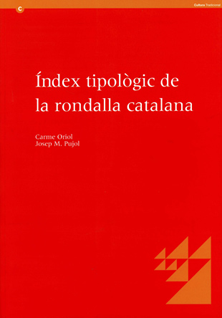The catalan folktale cataloguing project
The first catalogues
Cataloguing Catalan folktales according to the international typological index began with three studies: (1) the doctoral thesis of Josep Antoni Grimalt (1975), which studied Alcover’s Aplec (collection); (2) the degree dissertation of Josep M. Pujol (1982), which catalogued the remaining Catalan collections apart from Amades’; and (3) the degree dissertation of Carme Oriol (1984), which studied the tales collected by Amades and his dependence on earlier sources. Julio Camarena and Maxime Chevalier also catalogued Catalan folktales in their Catálogo tipológico del cuento folklórico español (1995-) and Carlos González Sanz catalogued the Catalan folktales of the Aragon Strip (1996, 1998).
The existence of all these catalogues made it necessary to create a typological catalogue of Catalan folktales which unified, brought up to date and completed these previous contributions.
In 2000, the university lecturers Carme Oriol and Josep M. Pujol obtained the funding necessary to start the project of cataloguing Catalan folktales. The first task was to create the RondCat database and, during 2000 and 2001, 4,819 tales were added from the folkloric collections which have been published in book form since 1853 - the year that Manuel Milà i Fontanals published 20 summaries of Catalan folktales in the Gaceta de Barcelona - up to December 2001 - the cut-off date for this phase in the cataloguing project.
The 'Índex tipològic de la rondalla catalana'

During 2002 and 2003 the printed edition of the catalogue was created from the information in the database. Only those types which corresponded to types included in the international index were chosen and the result was the Índex tipològic de la rondalla catalana (Typological index of Catalan folktales) (Oriol/Pujol 2003), which catalogues 2,049 stories from 82 collections compiled by 54 folklorists. The number of different plots included climbs to 546.
The catalogue has the following parts: animal tales, tales of magic, religious tales, realistic tales (novelle), tales of the stupid ogre, anecdotes and jokes, and formula tales.
On the basis of the Índex tipològic de la rondalla catalana, the ATU index includes systematic reference to Catalan folktale heritage.
The 'Index of Catalan Folktales'
Since the publication of the Índex tipològic de la rondalla catalana, new books of tales have been brought out. The data from all these stories has been put into RondCat and, provided it corresponds to the international index, the Index of Catalan Folktales (Helsinki: Suomalainen Tiedeakatemia 2008). This new index brings up to date the one published in Catalan, includes the changes introduced to the international ATU index and incorporates corrections to mistakes found in the Índex tipològic.
The tales which do not correspond to the international ATU
In 2005 second part of the project was started to catalogue those Catalan folktales which have no entry in the international index and which number approximately 3,000. Because they do not have plots which correspond to those described in the international index, these tales run the risk of being relegated to second place in folklore studies and, at the same time, of having a limited circulation. For this reason they have also been included in RondCat.
RondCat: The Catalan folktale search engine
In 2004, thanks to the help received through a teaching innovation project at the Rovira i Virgili University, and with the technical support of the University’s Educational Resources Service, the application “RondCat: Cercador de la rondalla catalana” (RondCat: The Catalan folktale search engine) was constructed, allowing the database to be consulted on the internet. This application has been improving and getting larger thanks to help from other teaching innovation projects obtained for subsequent editions.
RondCat helps the public to consult information related to Catalan folktales published in Catalan speaking territories and at the same time it is an instrument which allows systematic and permanent revision and updating.